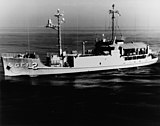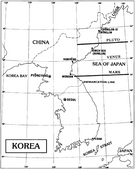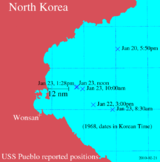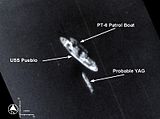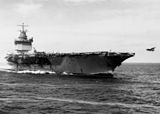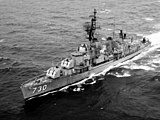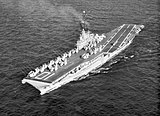User:Marcd30319/Operations Formation Star version C
| Operation Formation Star | |
|---|---|
| Part of Cold War, Korean Conflict, Pueblo Incident | |
 Defender Station | |
| Type | Contingency operations[Note 1] |
| Location | |
| Planned by | U.S. Seventh Fleet |
| Target | North Korea |
| Date | January 25, 1968 to March 22, 1968[1][2] |
| Executed by | Task Force 71 |
| Outcome | Show of force |
Operation Formation Star was the code name for the emergency re-deployment of U.S. Seventh Fleet warships to the Sea of Japan off the eastern coast of North Korea following that country's seizure of the USS Pueblo (AGER-2) in international waters on 23 January 1968.
Operation Formation Star was the largest build-up of U.S. naval forces around the Korean Peninsula since the Korean War, but it also placed a considerable strain on the United States Seventh Fleet's support for the Vietnam War, particularly its aircraft carrier operations at Yankee Station. Although a wide range of military options were considered, the Johnson Administration elected to resolve the Pueblo crisis diplomatically.
Background
[edit]Tensions along the Korean DMZ
[edit]Also referred to as a Second Korean War, the Korean DMZ Conflict was a series of low-level armed clashes between North Korean forces and the forces of South Korea and the United States, largely occurring between 1966 and 1969 at the Korean DMZ.[3] The number of incidents along the DMZ jumped from 37 in 1966 to 435 in 1967, with a combined 1967 total of 371 fatalities involving North Korea, South Korea, and United Nations forces while there were no fatalities in 1966. Also, during 1967, there were two sabotage attempts to disrupt South Korea railroad operations, the first such attempts since the Korean War. Finally, a South Korean patrol vessel was sunk by North Korea shore batteries over a fishing dispute.[4] In the most overt incident to date, North Korean commandos attempted unsuccessfully to assassinate the South Korea president Park Chung-hee at the presidential residence Blue House in Seoul, South Korea, on 21 January 21 1968.[5]
| 1964 | 1965 | 1966 | 1967 | 1968 | |
|---|---|---|---|---|---|
| Violent incidents | 32 | 42 | 37 | 435 | 542 |
| North Koreans killed | — | — | 45 | 228 | — |
| North Koreans captured | — | — | 19 | 57 | — |
| UNC forces killed | — | — | 39 | 122 | — |
| UNC forces injured | — | — | 26 | 294 | — |
| ROK police/civilians killed | — | — | 4 | 22 | — |
| UNC police/civilians injured | — | — | 5 | 53 | — |
Operation Clickbeetle
[edit]Operation Clickbeetle was the code-name for electronic and radio intelligence-gathering operations by small converted coastal cargo ships that operated close to potential enemies' coastline in international waters. The first vessel in this program was the Banner and the second was the Pueblo. Beginning in 1965, the Banner completed fifteen intelligence missions involving the Soviet Union and China, with only three missions also including North Korea. While both China and the Soviet Union in particular challenged Banner's presence off their coasts, the North Koreans virtually ignored the U.S. vessel. Banner and Pueblo were under the direct operational command of the Commander, Naval Forces Japan Rear Admiral Frank L. Johnson through the Task Force 96 command staff.
On 11 January 1968, Pueblo left Sasebo, Japan, and headed northward through the Tsushima Strait into the Sea of Japan. Pueblo's specific orders were to intercept and conduct surveillance of Soviet Pacific Fleet activity in the Tsushima Strait and to gather signal and electronic intelligence from North Korea. To maintain a low profile, no naval escort was provided nor were any land-based interceptor jets on stand-by alert for Pueblo's mission. After an uneventful mission to date, Pueblo was observed by a North Korea sub-chaser on 21 January 1968 in international water off Wonsan. On 23 January 1968, the Pueblo was shadowed by two North Korea fishing trawlers before being intercepted and boarded by a North Korean sub-chaser and three fast patrol boats, all outside North Korea's territorial waters.[6]
Operational summary
[edit]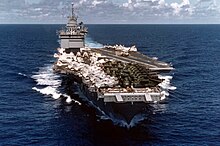

Initial response
[edit]On the day of the Pueblo's seizure, 23 January 1968, the closest U.S. naval force was Task Group 77.5 under the command of Rear Admiral Horace H. Epes, Jr. The task group consisted of the nuclear-powered attack aircraft carrier Enterprise (pictured), the nuclear-powered guided-missile frigate Truxtun, and the guided-missile frigate Halsey. Task Group 77.5 was steaming in the East China Sea en route to Yankee Station off North Vietnam. At the time of the initial alert, TG-77.5 was approximately 550 nautical miles (1,020 km; 630 mi) from the last reported position of the Pueblo or 470 nautical miles (870 km; 540 mi) from Wonsan, the nearest North Korean seaport to Pueblo.[7][8][9][10] Now re-designated Task Group 70.6, the Enterprise task group was ordered to proceed "at best speed" to the southern entrance of the Tsushima Strait. Also, the Pueblo's sister-ship, the Banner, was ordered to suspend its intelligence-gathering mission and return to Yokosuka, Japan, immediately.[11]
A number of factors prevented an immediate response from the Enterprise's embarked Carrier Air Wing Nine of 85 aircraft.[Note 2][8] The air wing's aircraft had sustained damage from a recent typhoon and those remaining 35 operational strike aircraft had to be re-spotted on the flight deck and armed with air-to-surface ordnance.[12][10] Additionally, the ship could not stage replacement aircraft through Japan due to the status of forces agreement that prohibited the combat use of U.S. military aircraft re-deployed from a neutral nation.[8][12]
Later on 23 January 1968, CINCPAC Admiral Ulysses S. Grant Sharp, Jr., USN, requested authorization from the U.S. Joint Chiefs of Staff for Task Group 70.6 carry out photographic reconnaissance of Wonsan to determine the location of the Pueblo.[13] Upon hearing about the seizure of the Pueblo, Admiral John J. Hyland, Jr., recognized the possibility of sending a warship into Wonsan harbor to board and recapture the Pueblo.[14] Accordingly, Hyland directed his U.S. Pacific Fleet headquarters staff to order the U.S. Seventh Fleet to divert a destroyer and "prepare to engage in operations that may include towing Pueblo and/or retrieval of Pueblo crew/provide air cover as appropriate." Vice Admiral William F. Bringle ordered his Seventh Fleet staff to divert the destroyer USS Higbee (DD-806) (pictured) to Wonsan as a contingency for such an operation.[15]
Early on 24 January 1968, the U.S. Pacific Fleet headquarters ordered Task Group 70.6 to remain below the 36th parallel north and take "no overt action until further informed." Subsequent orders directed the Enterprise task group to the Korea Strait, and to gain additional sea room, the task group temporarily withdrew to the East China Sea. Land-based anti-submarine patrols in support of Task Group 70.6 was limited to a two-plane barrier patrol. Finally, all signal intelligence-gathering flights over the Yellow Sea and the Sea of Japan were temporarily suspended until further notice. Also, the Higbee was recalled from Wonsan.[16]
On the evening of 25 January 1968, a high-altitude A-12 reconnaissance aircraft overflew Wonsan harbor and confirmed that the Pueblo was anchored there and surrounded by North Korean naval vessels (pictured above).[17][18]
Crisis management
[edit]

The U.S. Pacific Command and U.S. Pacific Fleet planning staffs offered a number of military options in response to the Pueblo crisis. These options were forwarded to the U.S. Joint Chiefs of Staff and the rest of the National Command Authority apparatus while the U.S Seventh Fleet and U.S. Fifth Air Force command staffs developed contingency plans. On Friday, 26 January 1968, the inter-agency Korea Working Group met to examine the military, diplomatic, and economic options in response to the Pueblo crisis:
- Selected air strikes on North Korea. This option involved ninety-two U.S. Navy, U.S. Air Force, and South Korean air force aircraft striking the North Korean air base at Wonsan and the naval base at Munp’yong-ni.
- Naval blockade of Wonsan. Leveraging carrier-based air cover, U.S. and possibly South Korean naval units could impose a blockade within Wonsan’s twelve-mile limit. To achieve air superiority, strikes against North Korean military airfields would “quite possibly” be required.
- Mine Wonsan Harbor. Carrier-based A-6 attack aircraft would fly seventeen sorties to drop eighty-three mines in one night, and thereafter the A-6 aircraft would “reseed” the minefield as necessary.
- Seize North Korean vessels. The option would act as retaliation in kind, seizing either a North Korean merchant vessel or a warship, and then using that vessel as a bargaining chip for the release of the Pueblo and its crew.
- Sail USS Banner into the area where Pueblo had been seized. This would demonstrate U.S. determination to exercise freedom of the seas positing the Banner (pictured) a minimum of thirteen miles from the North Korean coast for eight days. Two destroyers, a cruiser, and possibly a South Korean unit would escort the Banner, and carrier aircraft would fly cover overhead. U.S. Air Force aircraft in South Korea would be on “strip alert” status for immediate readiness to take off.
- Recover cryptographic material jettisoned by Pueblo. This recovery operation involve a U.S. Navy tug and mine warfare vessels from Sasebo, Japan, plus special detection gear from the United States. Carrier-based and land-based aircraft would provide air cover. The salvage unit would only operate during daylight, and the entire operation would terminate after ten days.
- Conduct airborne reconnaissance. This option involved flying reconnaissance missions in an attempt to convince North Korea that the United States was preparing for military operations, including electronic warfare missions.
- Inform the Soviets of actual or possible military moves. This option would use the Soviet Union as a "back channel" to warn the North Korea against further provocations.
- Raid across the Demilitarized Zone. This option involved a combine U.S.-ROK armored force raiding a major North Korean military post near the DMZ.
- Economic pressure on North Korea. This option involved a total trade embargo on by the United States and its allies, particularly a cessation of Japanese imports from North Korea and elimination of wheat exports.
On 29 January 1968, a senior advisory panel reviewed the working group's list of options and recommended a diplomatic, not military approach for ending the Pueblo crisis. To support this diplomatic effort, Operation Formation Star was initiated, with the Enterprise-led Task Group 70.06 serving initially as its centerpiece.[1]
- Task Group 70.6
| Escort screen | Carrier Air Wing Nine (CVW-9) squadrons embarked aboard flagship USS Enterprise (CVAN-65) | ||
|---|---|---|---|
| USS Truxtun (DLGN-35) | Fighter Squadron 96 (VF-96): 16 F-4B Phantom II | Reconnaissance Attack (Heavy) Squadron One (RVAH-1): 6 RA-5C Vigilante | |
| USS Ozbourn (DD-846) | Fighter Squadron 92 (VF-92): 13 F-4B Phantom II | Heavy Attack Squadron 2 (VAH-2), Detachment 65: 6 KA-3B Skywarrior | |
| USS Higbee (DDR-806) | Attack Squadron 113 (VA-56): 14 A-4E Skyhawk | Carrier Airborne Early Warning Squadron 112 (VAW-112): 4 E-2A Hawkeye | |
| USS Collett (DD-730) | Attack Squadron 56 (VA-56): 12 A-6A Intruder | Carrier Airborne Early Warning Squadron 13 (VAW-13), Detachment 65: 3 EKA-3B Skywarrior | |
| USS O'Bannon (DDE-450) | Attack Squadron 35 (VA-35): 14 A-4F Skyhawk | Helicopter Combat Support Squadron 1 (HC-1), Detachment 65: 3 UH-2C Seasprite | |
Naval build-up
[edit]

Task Force 71
[edit]Effective 25 January 1968, in conjunction with Operation Combat Fox, Operation Formation Star was initiated. Taken together, both operations represented a major surge deployment of U.S. naval and air forces into the Sea of Japan region off the eastern coast of North Korea, the largest since the end of the Korean War.[1] Although not directly unrelated to Operation Formation Star, the Republic of Korea Navy also dispatched nineteen ships and two fast patrol boats to sixteen patrol zones around South Korea.[19]
Concurrently with Operation Formation Star and Operation Combat Fox, U.S. President Lyndon B. Johnson signed Executive Order 11392 ordering certain units of the Ready Reserve of the Naval Reserve, Air Force Reserve, and Air National Guard of the United States to active duty.[20] For the U.S. Naval Reserve, this call-up involved six naval air squadrons and two Seabee construction battalions for a total of 1621 naval reservists activated.[21]
Also, on 25 January 1968, the newly augmented Enterprise-led Task Group 70.6 sailed through Tsushima Strait and into the Sea of Japan. The task group would operate below 36th parallel North during Operation Formation Star.[22][23] Between 24–26 January 1968, the destroyers Higbee, Ozbourn, Collett, and O'Bannon joined Task Group 70.6.[24]
On 27 January 1968, the attack aircraft carrier Ranger (pictured) was detached from Task Force 77 at Yankee Station off North Vietnam and ordered to the Sea of Japan as part of Operation Formation Star.[25] Likewise, the support aircraft carrier Yorktown was ordered to forego its scheduled port-call in Japan and divert to the Sea of Japan.[26]
By 1 February 1968, Yorktown, Ranger and Enterprise were operating in the Sea of Japan as Task Force 71 under the command of Rear Admiral Horace H. Epes, Jr., with the Enterprise as his flagship.[19][8][27] TF-71 was organized into a two-carrier strike group, a surface action group, and an anti-submarine warfare (ASW) unit centered around the Yorktown and her escorts.[28]
Additional ASW assets for Operation Formation Star included land-based Lockheed SP-2H Neptune and Lockheed P-3A/B Orion maritime patrol aircraft from patrol squadrons VP-2, VP-17, VP-19, and VP-48.[29] Between 24-31 January 1968, Neptune and Orion patrol aircraft flew over 50 ASW barrier patrols over the Sea of Japan and subsequently flew an additional 238 mission in February. This operational tempo placed such a burden on patrol aircraft based in Japan that additional aircraft from Okinawa and the Philippines were used to augment the barrier patrols.[30]
Of the seventeen U.S. submarine then deployed in the Far East, nine nuclear and non-nuclear submarines were ordered to the Korean Peninsula for up to three months of operations in the Sea of Japan on 27 January 1968. Also, the return of two submarines deployed in the Far East was delayed because of the Pueblo crisis while three additional submarines were dispatched to the U.S. Seventh Fleet in response to the crisis. The GUPPY IIA Diesel-electric submarine Ronquil was specifically tasked for cover and search-and rescue operations during the Pueblo crisis.[31]
The area air defense for Task Force 71 was greatly enhanced when the guided-missile cruiser Chicago (pictured) was detached from PIRAZ duty off Vietnam for operations in the Sea of Japan on 28 January 1968. Equipped with modernized electronic systems, an improved combat information center using the Naval Tactical Data System (NTDS), and long-range RIM-8 Talos anti-aircraft missiles, Chicago coordinated air activities for the TF-71 aircraft carriers.[32] The Canberra and Providence were the other two guided-missile cruisers assigned to Task Force 71, joining the guided-missile frigates Bainbridge and Halsey.
To support Task Force 71, Task Force 73 created an underway replenishment group that included the fast combat support ship Sacramento; the fleet oilers Platte and Tolovana, the combat stores ship Mars; and the ammunition ship Vesuvius.[33][34] To service TF-71's flotilla of destroyers, the destroyer tender Samuel Gompers was deployed to Sasebo, Japan.[35]
- Task Force 71, 1968
| Carrier Groups | Screening Force | ||||
|---|---|---|---|---|---|
| Aircraft Carriers | Carrier Air Wing | Cruisers / Destroyer Leaders | Destroyers | Destroyers | Destroyers / Destroyer Escorts |
| USS Enterprise (CVAN-65)[Note 3] | Carrier Air Wing 9 | USS Canberra (CAG-2) | USS Leonard F. Mason (DD-852) | USS James E. Kyes (DD-787) | USS John A. Bole (DD-755) |
| USS Ranger (CVA-61)[Note 4] | Carrier Air Wing 1 | USS Chicago (CG-11) | USS Ozbourn (DD-846) | USS Henderson (DD-785) | USS Taussig (DD-746) |
| USS Coral Sea (CVA-43)[Note 5] | Carrier Air Wing 15 | USS Providence (CLG-6) | USS Herbert J. Thomas (DD-833) | USS McKean (DD-784) | USS Collett (DD-730) |
| USS Ticonderoga (CVA-14)[Note 6] | Carrier Air Wing 19 | USS Truxtun (DLGN-35) | USS Hanson (DD-832) | USS Rowan (DD-782) | USS O'Bannon (DDE-450) |
| USS Kearsarge (CVS-33)[Note 7] | ASW Air Group 53 | USS Halsey (DLG-23) | USS Everett F. Larson (DD-830) | USS Buck (DD-761) | USS Bradley (DE-1041) |
| USS Yorktown (CVS-10)[Note 8] | ASW Air Group 55 | —— | USS Higbee (DDR-806) | USS Strong (DD-758) | —— |
USS Banner re-deployment
[edit]In conjunction with the naval build-up in the Sea of Japan under Operations Formation Star, the USS Banner (AGER-1) was deployed to the Sea of Japan off the east coast of North Korea. The objective of this re-deployment was to reassert the right to carry out intelligence-gathering operations in international waters. Unlike the Pueblo, the command-and-control apparatus during Banner's deployment was under the direct control of the U.S. Joint Chiefs of Staff via Admiral Ulysses S. Grant Sharp, Jr., USN, the Commander-in-Chief of the U.S. Pacific Command.
Soviet reaction
[edit]Beginning in mid-1950s, The United States Navy took note of the use of Soviet fishing trawlers as intelligence-gathering vessels operating near the United States. Often such trawlers interfered with the navigation of U.S. naval vessels, particularly surfaced submarines. Starting in early 1963, long-range land-based Soviet bombers began overflying U.S. aircraft carriers (pictured), often resulting in the disruption of flight operations.[36]

As the Pueblo crisis unfolded, the presence of such a large U.S. naval force in the Sea of Japan prompted the Soviet Union to deploy its own warships and naval aircraft to the area in response. The USSR's Red Banner Pacific Fleet initially deployed a Kildin-class destroyer, a Kotlin-class destroyer, a Riga-class frigate, two intelligence-gathering trawlers, four fleet tankers, and a water tender in response to the U.S. naval force in the Sea of Japan.[22]
On 25 January 1968, the Enterprise-led Task Group 70.6 sailed past the Riga-class frigate and Uda-class oiler patrolling the entrance of Tsushima Strait. Later that same day, a Kashin-class destroyer began trailing TG-70.6 in the Sea of Japan. The Kotlin-class destroyer subsequently joined in shadowing the now-activated Task Force 71.[22][23]
By 5 February 1968, a picket line of Soviet warships formed along the 38th parallel North that included two Kynda-class cruisers and three Kashin-class destroyers. Also, on that date, another six Soviet destroyers steamed into the Sea of Japan, as well as at least two Soviet submarines were also operating in Sea of Japan. Ultimately, the Soviet fleet commander, Admiral Nikolay N. Amelko, committed fully half of his cruiser-destroyer forces based in Vladivostok to monitor U.S. naval forces during the Pueblo crisis.[22][23][37]
Pacific-based Soviet Naval Aviation maritime patrol bombers were also flying multiple daily missions to monitor Task Force 71. On 7 February 1968 alone, ten Tupolev Tu-16 Badger bombers approached U.S. naval forces at altitudes between 500 ft (150 m) and 30,000 ft (9,100 m).[22] Between 23 January and 21 February 1968, the U.S. Seventh Fleet reported 14 cases of harassment by Soviet naval vessels, with the most damaging on 1 February 1968 when the U.S. destroyer Rowan and the 10,000-dwt Soviet freighter Kapitan Vislobokov punched above-the-waterline holes in their hulls during a collision.[38][39] This latter incident prompted a formal Soviet protest on 2 February 1968 and a counter-protest from the United States on 4 February.[40]
On 22 February 1968, Admiral John J. Hyland, Jr., transmitted a detailed U.S. Pacific Fleet communique to CINCPAC Admiral Ulysses S. Grant Sharp, Jr., detailing the increased number of at-sea incidents between Soviet and American naval vessels in the Sea of Japan. The Hyland communique cited 14 specific incidents, with "many of all deliberately intended" to be harassing U.S. naval operations. On 1 March 1968, Admiral Sharp forwarded the Hyland communique to the U.S. Joint Chiefs of Staff. The JSC formed a panel to examine the subject and adopted the OPNAV position on negotiating a diplomatic agreement to reduce at-sea incidents with the USSR.[41]
Stand-down
[edit]Operation Formation Star placed a considerable strain on the United States Seventh Fleet's support for the Vietnam War, particularly aircraft carrier operations at Yankee Station. Two days before the capture of the Pueblo, 21 January 1968, North Vietnamese Army began its seige against Khe Sanh Combat Base near the the Vietnamese Demilitarized Zone (DMZ) . Seven days after the Pueblo crisis started, the Viet Cong and North Vietnamese People's Army of Vietnam launched the Tet Offensive, a campaign of surprise attacks against military and civilian commands and control centers throughout South Vietnam. Concurrent with both events, Task Force 77's support of Operation Rolling Thunder was greatly hampered by poor weather conditions over North Vietnam.[42]
Chief of Naval Operations Admiral Thomas H. Moorer advised the U.S. Joint Chiefs of Staff that Task Force 71 as constituted could operate up to six weeks before carriers operations off without degrading Seventh Fleet's carrier operations in Vietnam.[43] As an interim solution, a scheduled rest and recreation period for the attack carrier Kitty Hawk was cancelled in order to stay at Yankee Station. Also, the tour of duty for the attack carrier Coral Sea was extended by an additional month, and extending the deployment of the attack carrier Oriskany was also considered. With the Pueblo crisis evolving towards a diplomatic conclusion, U.S. naval operations in the Sea of Japan began to wind down.[42][43]
Aftermath
[edit]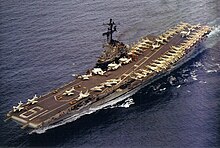
Although a wide range of military options were considered, the Johnson Administration elected to resolve the Pueblo crisis diplomatically. However, the periodic rotation of U.S. aircraft carrier task forces to off the North Korean coast in the Sea of Japan provided additional leverage to American negotiators in talks to repatriate the crew of the Pueblo.[2]
Legacy
[edit]Task Force 71 was reconstituted following the 1969 shoot-down of a EC-121 reconnaissance aircraft in international airspace by the North Korean Air Force, with the USS Enterprise again serving as its flagship. While indirectly related to Operation Formation Star, the National Security Archive noted an interesting albeit ironic legacy of the Pueblo crisis:
When it departed from Japan, the Pueblo carried four different types of encryption machines: a KL-47 for offline encryption, two KW-7s for online encryption, three KWR-37s for receiving fleet-wide operational intelligence broadcasts, and four KG-14s, used in conjunction with the KWR-37s. According to this damage report, the crew's frantic efforts while under attack to destroy classified materials were "ineffective" and "a majority" of the code machines and their associated keying material and maintenance and operating manuals were compromised. However, the report says, since the communists lacked the key cards needed to operate the code machines, "the absolute threat to U.S. [secret] communications resulting from the loss of cryptographic equipment is minimal." What the NSA analysts did not know at the time was that the Soviets were secretly buying Navy codes and a wide variety of other classified documents from John Anthony Walker Jr., a Navy radio specialist turned traitor. Walker and several associates continued to steal and sell U.S. military secrets to Moscow for an astonishing 18 years, until the FBI finally arrested him.
One member of the Walker spy ring was longtime friend and former senior chief petty officer Jerry Whitworth whose last posting was on the USS Enterprise. Prior to his retirement, Whitworth's last espionage packet her passed to Walker was the operational detail for FleetEx 83, the largest U.S. naval exercise in the north Pacific up to that time.
See also
[edit]Notes
[edit]- Footnotes
- ^ See Military options section of this article for details.
- ^ (CVW-9) consisted of 26 F-4 Phantom II jet fighters, 26 A-4 Skyhawk attack aircraft, six RA-5 recon aircraft, 15 A-6 Intruders all-weather attack bombers, five A-3 Skywarrior ELINT aircraft, four E-2 Hawkeye AEW aircraft, and three SH-2 Seasprite helicopters.
- ^ Assigned to Carrier Division 7.
- ^ Assigned to Carrier Division 3.
- ^ Assigned to Carrier Division 7.
- ^ Assigned to NAVAIRPAC.
- ^ Assigned to NAVAIRPAC.
- ^ Assigned to NAVAIRPAC.
- Citations
- ^ a b c d Mobley, Richard (Spring 2001). "Pueblo: A Retrospective". Naval War College Review. 54 (2). Naval War College: 99, 111. Retrieved 2 July 2015.
Hereafter referred to as: Mobley. "Pueblo: A Retrospective"
- ^ a b Mobley, Richard A. Flash Point North Korea: The Pueblo and EC-121 Crises. p. 78.
Hereafter referred to as: Mobley. Flash Point North Korea.
- ^ Mitchell Lerner (December 2010). ""Mostly Propaganda in Nature:" Kim Il Sung, the Juche Ideology, and the Second Korean War" (Document). The North Korea International Documentation Project.
{{cite document}}: Unknown parameter|accessdate=ignored (help); Unknown parameter|url=ignored (help) - ^ Mobley. Flash Point North Korea, P. 14.
- ^ Bolger, Daniel P. (1991). Scenes from an Unfinished War: Low intensity conflict in Korea 1966–1969. Leavenworth Papers #19. p. Chapter 3 The Moment of Crisis. ISBN 978-0-7881-1208-9.
Hereafter referred to as: Bolger. Scenes from an Unfinished War.
- ^ Mobley, Flash Point North Korea, pp. 24, 28, 39, 40–42.
- ^ Mobley. Flash Point North Korea, pp. 43–44.
- ^ a b c d "USS Enterprise (CVAN-65), 1966-1970". Dictionary of American Naval Fighting Ships. Navy Department, Naval History & Heritage Command. Retrieved 2015-06-30.
- ^ Lee, Kent (1968). "USS Enterprise (CVAN-65) Command History for 1 January 1968 to 31 December 1968" (PDF). Washington Navy Yard: Naval History & Heritage Command. Retrieved 2015-07-02.
Captain Kent Lee, USN, was the commanding officer of the USS Enterprise (CVAN-65)
- ^ a b Cheevers, Jack (2013). Act of War: Lyndon Johnson, North Korea, and the Capture of the Spy Ship Pueblo. New York City: NAL Caliber. pp. 77–79. ISBN 978-0-451-46620-4. Retrieved 2015-07-03.
Hereafter referred to as: Cheevers . Act of War
- ^ Mobley. Flash Point North Korea, p. 45–46.
- ^ a b Mobley. Flash Point North Korea, p. 44.
- ^ Mobley. Flash Point North Korea, pp. 45–46.
- ^ Cheevers . Act of War, 108.
- ^ Mobley. Flash Point North Korea, p. 46.
- ^ Mobley. Flash Point North Korea, p. 47.
- ^ Mobley. Flash Point North Korea, p. 54.
- ^ Cheevers. Act of War, p. 114.
- ^ a b Mobley. Flash Point North Korea, p. 66.
- ^ "Executive Orders Disposition Tables". Lyndon B. Johnson - 1968. National Archives and Records Administration. 25 January 1968. Retrieved 2015-07-03.
33 FR 951; January 26, 1968
- ^ Kapp, Lawrence (August 14, 2000). "Involuntary Reserve Activations for U.S. Military Operations Since World War II". Washington, DC: Congressional Research Service. pp. 9–10. Archived from the original on February 2, 2009. Retrieved 2015-07-03.
- ^ a b c d e Mobley. Flash Point North Korea, p. 68.
- ^ a b c Mobley,"Pueblo: A Retrospective," p.103.
- ^ Cite error: The named reference
Mobley47was invoked but never defined (see the help page). - ^ Francillon, René J. Tonkin Gulf Yacht Club: U.S. Carrier Operations off Vietnam. pp. 62, 157.
Here after referred to as: Francillon. Tonkin Gulf Yacht Club.
- ^ "USS Yorktown (CVS-10)". Dictionary of American Naval Fighting Ships. Navy Department, Naval History & Heritage Command. Retrieved 2015-07-03.
- ^ Cheevers. Act of War, pp. 124.
- ^ Mobley. Flash Point North Korea, pp. 66–67.
- ^ Roberts, Michael D. (2000). "Dictionary of American Naval Aviation Squadrons, Volume 2: The History of VP, VPB, VP(H) and VP(AM) Squadrons, Chapter 3". Washington, D.C.: Naval Historical Center. pp. 27–28, 99, 101–103, 109–112, 287, 289–290. Retrieved 2015-07-03.
- ^ Mobley. Flash Point North Korea, p. 67.
- ^ Mobley. Flash Point North Korea, pp. 52, 66.
- ^ "USS Chicago (CG-11)". Dictionary of American Naval Fighting Ships. Navy Department, Naval History & Heritage Command. Retrieved 2015-07-04.
- ^ "USS Platte (A0-25)". Dictionary of American Naval Fighting Ships. Navy Department, Naval History & Heritage Command. Retrieved 2015-07-06.
- ^ "USS Vesuvius (AE-15)". Dictionary of American Naval Fighting Ships. Navy Department, Naval History & Heritage Command. Retrieved 2015-07-06.
- ^ "USS Samuel Gompers (AD-37)". Dictionary of American Naval Fighting Ships. Navy Department, Naval History & Heritage Command. Retrieved 2015-07-06.
- ^ Winkler, David F. Cold War at Sea: High-Seas Confrontation Between the United States and the Soviet Union. pp. 29–34.
Here after referred to as: Winkler. Cold War at Sea.
- ^ "Has the "Fire!" Command Sounded in the Compartments of the Cold War?". Russian Navy. Mil.Today. 2015. Retrieved 2015-07-01.
- ^ Mobley. Flash Point North Korea, pp. 68–69.
- ^ Cheevers. Act of War, pp. 124–125.
- ^ Winkler. Cold War at Sea, p. 189.
- ^ Winkler. Cold War at Sea, p. 59.
- ^ a b Francillon. Tonkin Gulf Yacht Club. pp. 61, 104.
- ^ a b Mobley. Flash Point North Korea, p. 52.
Sources
[edit]![]() This article incorporates text from the public domain Dictionary of American Naval Fighting Ships.
This article incorporates text from the public domain Dictionary of American Naval Fighting Ships.
- Bolger, Daniel P. (1991). "Scenes from an Unfinished War: Low intensity conflict in Korea 1966–1969" (PDF). Command Operations Reports. Fort Leavenworth: Leavenworth Papers #19. Retrieved 30 June 2015.
- Cheevers, Jack (2013). Act of War: Lyndon Johnson, North Korea, and the Capture of the Spy Ship Pueblo (Paperback) (First ed.). New York: NAL Caliber. ISBN 978-0-451-46620-4.
- Francillon, René J. (1988). Tonkin Gulf Yacht Club: U.S. Carrier Operations off Vietnam (First ed.). Annapolis, Maryland: Naval Institute Press. ISBN 978-0-870-21696-1.
- Grossnick, Roy A. (1995). Dictionary of American Naval Aviation Squadrons Volume 1. Annapolis, Maryland: Naval Institute Press. ISBN 978-0-945-27429-2.
- Mobley, Richard A. (2003). Flash Point North Korea: The Pueblo and EC-121 Crises. Annapolis, Maryland: Naval Institute Press. ISBN 978-1-557-50403-6.
- Mobley, Richard A. (Spring 2001). "Pueblo: A Retrospective". Naval War College Review. 54 (2). Naval War College: 98–117. Retrieved 2 July 2015.
{{cite journal}}: Unknown parameter|authormask=ignored (|author-mask=suggested) (help) - Polmar, Norman (2008). Aircraft Carriers: A History of Carrier Aviation and Its Influence on World Events: Vol. II, 1946-2006. Dulles, Virginia: Potomac Books, Inc. ISBN 978-157488-665-8.
Here after referred to as: Polmar. Aircraft Carriers, Vol. 2.
- Roberts, Michael D. (2000). Dictionary of American Naval Aviation Squadrons Volume 2 The History of VP, VPB, VP(H) and VP(AM) Squadrons. Washington Navy Yard: Naval Historical Center.
CHAPTER 3: Patrol Squadron (VP) Histories VP-1 to VP-153.
- Winkler, David F. Cold War at Sea: High-Seas Confrontation Between the United States and the Soviet Union.
Here after referred to as: Winkler. Cold War at Sea.
External links
[edit]- Inquiry Into the U.S.S. Pueblo and EC-121 Plane Incidents: Special Subcommittee on the U.S.S. Pueblo of the United States House Committee on Armed Services - 91st United States Congress - July 28, 2969
- National Security Archive Electronic Briefing Book No. 453: USS Pueblo: LBJ Considered Nuclear Weapons, Naval Blockade, Ground Attacks in Response to 1968 North Korean Seizure of Navy Vessel, Documents Show dated January 23, 2014 - National Security Archive - George Washington University
Category:Conflicts in 1968 Category:1968 in North Korea Category:1968 in the United States Category:North Korea–United States relations Category:Wars involving North Korea Category:History of the United States Navy Category:Cold War military history of the United States

